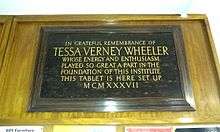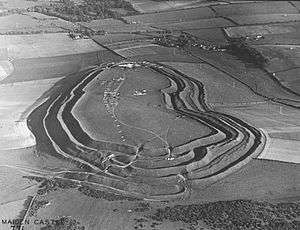Tessa Wheeler
Tessa Verney Wheeler (27 March 1893 – 15 April 1936) was an archaeologist, perhaps best known as the wife and professional partner of Mortimer Wheeler. The Wheelers undertook major excavations in Wales and England – including Segontium, Caerleon and Verulamium – and their investigation of Maiden Castle in Dorset had been running for two years when she died unexpectedly from complications following a minor operation.
Early and private life
Tessa Verney was born in Johannesburg, the daughter of a doctor. She had an elder half-brother from her mother's first marriage. The family moved to Lewisham, with her mother's third husband, a chemist. She was educated at Addey and Stanhope School in Deptford, and read history at University College London from 1911 to 1914. She met her future husband Mortimer Wheeler in 1912, and they were married in May 1914. He served in the artillery in the First World War, initially as an instructor in the University of London Officers' Training Corps, and later at other places in Scotland and England. She accompanied Mortimer on his postings until he was sent to France in 1917. Their only child, a son Michael, was born in January 1915. Michael later became a barrister and judge.
Career

Tessa followed Mortimer to Cardiff in 1920 when he took up a post at the National Museum of Wales. He was Director of the National Museum of Wales from 1924 to 1926. They undertook excavations together at Segontium in 1921–22 and at Gaer in 1924–25, working as a team. Tessa organised the excavations and recorded the finds, and Mortimer interpreted the results. They were preparing an excavation at Caerleon in 1926 when Mortimer was appointed Keeper of the London Museum. The family moved to London, but Tessa undertook the excavation on her own in the winter of 1926–27.
The excavation methods they used, for example the grid system (later developed further by Kathleen Kenyon and known as the Wheeler-Kenyon method), were significant advances in archaeological method, although later superseded. They were influenced greatly by the work of the archaeologist Lieutenant General Augustus Pitt Rivers (1827–1900). The two constant themes in their attempts to improve archaeological excavation were, first, to maintain strict stratigraphic control while excavating (for this purpose, the baulks between trenches served to retain a record of the strata that had been dug through), and, second, to publish the excavation promptly and in a form that would tell the story of the site to the intelligent reader. They also published their results quickly after the excavations concluded, and Mortimer proved adept at generating favourable publicity.
She became a lecturer at the London Museum in 1928, and became the second woman to be elected as a fellow of the Society of Antiquaries the same year. The Wheelers worked together on establishing an Institute of Archaeology in London, which was founded in 1934 and opened in 1937. She was an effective lecturer and teacher of the next generation of archaeology students.

The Wheelers continued to work together, performing many major excavations within Britain, including that of the Roman villa at Lydney Park in 1928–29, Roman Verulamium (modern-day St Albans) in 1930–34, and the late Iron Age hill-fort of Maiden Castle, Dorset. The work from Caerleon, Lydney, and St Albans were published under their joint names.
Her later life was blighted by the open unfaithfulness of her sexually adventurous husband, and she also suffered from ill health, including blackouts and gastric problems. She may have exacerbated her symptoms from over-work and a desire to meet the exacting demands of her husband. After a minor operation in early 1936, she became seriously ill and died from a pulmonary embolism at the National Temperance Hospital in London. Her remains were cremated at Golders Green crematorium.
She spent much of her early career in the shadow of her husband, like many earlier female archaeologists, but later work was published under their joint names and their contemporaries considered "the Wheelers" to be a team; some considered her to be the more talented field archaeologist. A black marble memorial plaque was unveiled at the Institute of Archaeology in 1937. A biography was published by Lydia Carr in 2012.
Notes
References
- Jane McIntosh, ‘Wheeler, Tessa Verney (1893–1936)’, Oxford Dictionary of National Biography, Oxford University Press, 2004; online edition, September 2012 accessed 11 March 2013
- Tessa Verney Wheeler: researcher, excavator, teacher, communicator – and wife, Antiquity
- Ghost hunting: Research memories of Tessa Verney Wheeler, OUPblog
- Tessa Verney Wheeler: Women and Archaeology Before World War Two, Lydia C. Carr
- UCL archives
- Association of Roman Archaeology Bulletin 18, p. 7–8